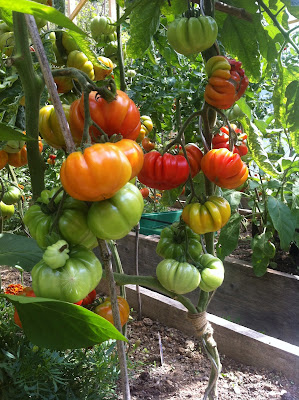Since returning from my trip to France and Spain I’ve been
musing over some of the things I noticed. I must admit I’ve become slightly
obsessed with the cultural differences between us and our European friends. In
particular, the way their deep rooted, cultural relationship with food enables
them to live a little more healthily and sustainably. Being more aware of these
differences has changed (or maybe just reinforced) the way I think about our
food system in the UK and is influencing what I buy and the way I eat.
I’m
in awe of how connected people in France and Spain are to the land around them.
Growing one’s own food and buying direct from local producers at vibrant food
markets is a normal part of everyday life. Before working on farms I felt like
I was aware of the basic food shop dos and don’ts: avoid intensively farmed
meat, buy free range organic eggs, be aware of seasons and food miles etc. I
didn’t always stick to my rules but I now think that’s partly because I hadn’t
fully grasped how brilliant eating local, seasonal food really is. There really is no comparison between the insanely delicious
taste of a tomato plucked from the vine in high summer with the all year-round
supply of bland, thick skinned, chemically ripened supermarket offerings. I
felt a real sadness when we harvested the last tomato at the end of the summer.
Not a tomato in sight till the end of May? Shock horror! But, thanks to bottling
during the glut, we enjoyed deeply rich and sunny tomato sauce well into the
depths of winter. Now that I’m back
in the UK, my habits have changed. I’m not attracted to the piles of tomatoes
on offer and find myself striding over to the roots and the brassicas when I
want salad. I’d rather not wait until good fresh tomatoes come back in late May
but it doesn’t feel like much of a sacrifice anymore.
The connection to where food comes from was particularly
strong in the village of Sandonaña in Cantabria where we had the privilege of
living for a month. Cantabria is steeped in its dairy
farming traditions and is the basis for their incredible fresh cheeses like Queso
Nata, and devilishly delicious, yet simple deserts like Quesada Pasiega and Sobao Pasiego.
The recipes have been passed down for generations unchanged. Sandonaña is a
village where pretty much everyone not only grows their own vegetables but also
owns chickens, pigs and even small herds of dairy cows! They wouldn’t consider
themselves as farmers but also wouldn’t think twice about planting 700 onion
sets for themselves. Normal people grow
and rear their own food and local producers competed with, and were even
embraced by, large supermarkets.
There’s no doubt that eating in these ways supports a more
localised food system and is one deeply engrained in both French and Spanish
culture. I’m not saying that either are perfect but I have been inspired by the
way the far end of the supply chain is often within walking distance. I also
can’t help thinking that their communities are more resilient in the face of a
changing economy and climate.
For time poor, city folk without the luxury of a garden, this can
seem a bit pie in the sky. But help is available to prove the contrary. Seasons is a nifty
app that acts as a harvest calendar that you can carry in your pocket. It tells
us when produce is at its best and even gives you lists of local farmers
markets.
The incredible Food Assembly is a pioneering community network who make it easier for us to get hold of local produce. It enables growers and farmers to list a changeable array of seasonal offerings and connects them with customers who can order online and collect face to face after working hours.
There are so many others too, so I’ll endeavour to keep sharing the wonderful things as I find them. Then we can all be satisfied in knowing what we’re eating and exactly where in the world it has come from.
The incredible Food Assembly is a pioneering community network who make it easier for us to get hold of local produce. It enables growers and farmers to list a changeable array of seasonal offerings and connects them with customers who can order online and collect face to face after working hours.
There are so many others too, so I’ll endeavour to keep sharing the wonderful things as I find them. Then we can all be satisfied in knowing what we’re eating and exactly where in the world it has come from.















.JPG)
.jpg)
.jpg)
.jpg)






.jpg)